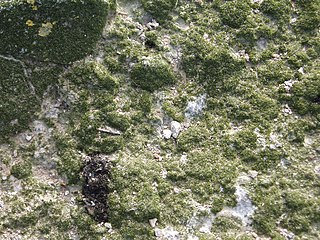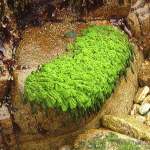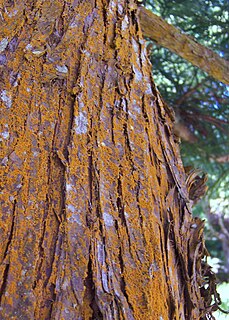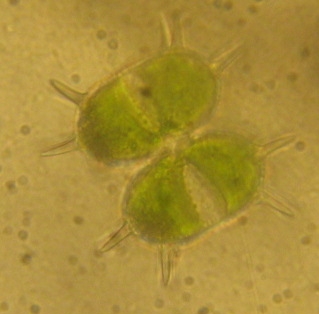
Chlamydomonadales, also known as Volvocales, are an order of flagellated or pseudociliated green algae, specifically of the Chlorophyceae. Chlamydomonadales can form planar or spherical colonies. These vary from Gonium up to Volvox. Each cell has two flagella, and is similar in appearance to Chlamydomonas, with the flagella throughout the colony moving in coordination.

Ulothrix is a genus of green algae in the family Ulotrichaceae.

Mamiellales are an order of green algae in the class Mamiellophyceae. Their cells and flagella are covered with spiderweb-like scales of several types. Some species lack scales but possess pigments similar to those of the scale-bearing species.

Prasiolales is an order of green algae in the class Trebouxiophyceae.

Ulotrichales is an order of green algae in the class Ulvophyceae.

Aphanochaetaceae is a family of algae in the order Chaetophorales.

Cladophoraceae are a family of green algae in the order the Cladophorales. This family includes notably the genus Chaetomorpha which has a few members used in saltwater aquariums.
Coccomyxaceae is a family of algae, in the order Chlorococcales.

Trentepohliaceae are a family of green algae in the order Trentepohliales.
In taxonomy, Ascochloris is a genus of green algae. It is classified within the order Sphaeropleales.
Monomastix is a genus of green algae in the class Mamiellophyceae. It is the only genus in the family Monomastigaceae, which in turn is the only family in the order Monomastigales.
Physolinum is a genus of green algae in the family Trentepohliaceae. The only species in the genus, Physolinum monilia, is currently regarded as a synonym of Trentepohlia rigidula.

Trentepohlia is a genus of filamentous chlorophyte green algae in the family Trentepohliaceae, living free on terrestrial supports such as tree trunks and wet rocks or symbiotically in lichens. The filaments of Trentepohlia have a strong orange colour caused by the presence of large quantities of carotenoid pigments which mask the green of the chlorophyll.
In taxonomy, Bambusina is a genus of fresh-water green algae, specifically of the Desmidiaceae.

Cosmarium is a genus of fresh water organisms belonging to the Charophyta, a division of green algae from which the land plants (Embryophyta) emerged.

In taxonomy, Euastrum is a genus of green algae, specifically of the Desmidiaceae.
Genicularia is a genus of green algae, specifically of the Gonatozygaceae.

Penium is a genus of green algae, and the sole member of the family Peniaceae. The genus contains about 39 species.
In taxonomy, Sphaerozosma is a genus of green algae, specifically of the Desmidiaceae.

In taxonomy, Xanthidium is a genus of green algae, specifically of the Desmidiaceae.












